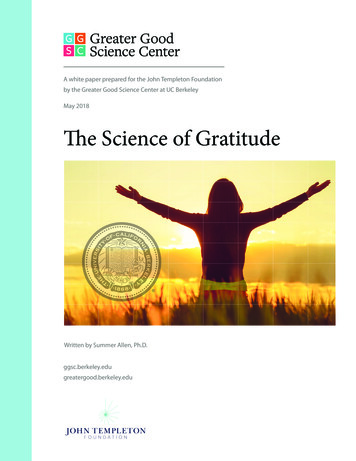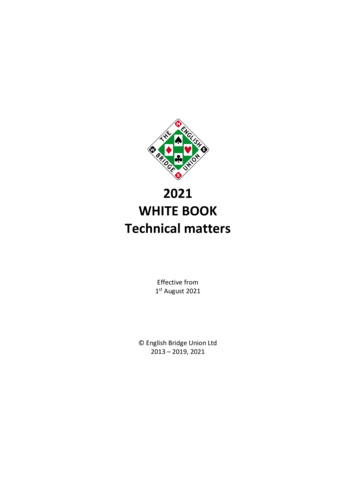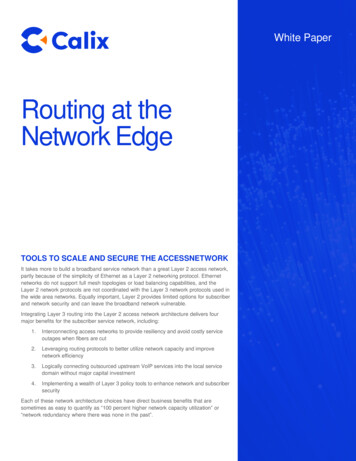
Transcription
A white paper prepared for the John Templeton Foundationby the Greater Good Science Center at UC BerkeleyMay 2018The Science of GratitudeWritten by Summer Allen, Ph.D.ggsc.berkeley.edugreatergood.berkeley.edu
The Science of GratitudeEXECUTIVE SUMMARYThroughout history and around the world, religious leaders and philosophers have extolled the virtue ofgratitude. Some have even described gratitude as “social glue” that fortifies relationships—between friends,family, and romantic partners—and serves as the backbone of human society.But what exactly is gratitude? Where does it come from? Why do some people seem to be naturallymore grateful than others? And are there ways we can foster more feelings and expressions of gratitude?Over the past two decades scientists have made great strides toward understanding the biologicalroots of gratitude, the various benefits that accompany gratitude, and the ways that people can cultivatefeelings of gratitude in their day-to-day lives. The studies comprising this science of gratitude are thesubject of this paper.What Is Gratitude?Most people have an instinctive understandingof what gratitude is, but it can be surprisinglydifficult to define. Is it an emotion? A virtue? Abehavior? Indeed, gratitude can mean differentthings to different people in different contexts.However, researchers have developed someframeworks for conceptualizing gratitude sothat it can be studied scientifically.For example, Robert Emmons and MichaelMcCullough define gratitude as a two-stepprocess: 1) “recognizing that one has obtained apositive outcome” and 2) “recognizing that thereis an external source for this positive outcome.”Executive SummaryWhile most of these positive benefits come fromother people—hence gratitude’s reputation asan “other-oriented” emotion—people can alsoexperience gratitude toward God, fate, nature, etc.Some psychologists further categorize threetypes of gratitude: gratitude as an “affective trait”(one’s overall tendency to have a grateful disposition), a mood (daily fluctuations in overall gratitude), and an emotion (a more temporary feelingof gratitude that one may feel after receiving agift or a favor from someone). Most of the studiesin this paper focus on trait (or “dispositional”gratitude) and/or gratitude as an emotion.2
The Origins Of GratitudeResearch suggests that gratitude is not simplya cultural construct. It has deep roots that areembedded in our evolutionary history, our brainsand DNA, and in child development.Animals as diverse as fish, birds, and vampirebats engage in “reciprocal altruism” activities—behaviors that one animal performs to helpanother member of their species, even at a cost tothemselves, presumably because they recognizeat some instinctual level that the other individual may repay the favor at a later date. Manyscientists see this desire to repay generosity asan expression of gratitude. In fact, some scientists suggest that gratitude may have evolved asa mechanism to drive this reciprocal altruism,thereby turning strangers into friends and allieswho are more likely to help one another.Support for the idea that gratitude may havearisen as an evolutionary adaptation comes inpart from research on primates. Studies havefound that chimpanzees are more likely to sharefood with a chimpanzee that had groomed themearlier in the day and are more likely to helpanother chimpanzee with a task if that chimpanzee had helped them in the past.Studies from neuroscience have identifiedbrain areas that are likely involved in experiencing and expressing gratitude, providing furtherevidence for the idea that gratitude is an intrinsiccomponent of the human experience. Additionally, a few studies have identified specific genes thatmay underlie our ability to experience gratitude.Recent studies have also begun exploring thedevelopmental roots of gratitude. This work suggeststhat even fairly young children have some conceptof gratitude that develops as they mature. Again, thissuggests that the roots of gratitude run deep.Executive SummaryIndividual Factors Linked To GratitudeEven if humans as a species have a general propensity for gratitude, what determines whether anindividual feels grateful or not? Research haslinked a variety of factors—including personalityfactors, cognitive factors, and gender—to one’slikelihood of experiencing gratitude or having agrateful disposition.Several studies have explored whethercertain personality factors—such as extraversion, agreeableness, conscientiousness, neuroticism, or openness to experience—are associatedwith dispositional gratitude; their results havediffered. Other studies have found evidencesuggesting that gratitude may be conceptualizedas its own personality factor.There are a number of cognitive factors thatcan influence how much gratitude a person feelsin a certain situation. These include the perceivedintentions of the benefactor (i.e., whether thebenefactor was seen as acting out of pure altruism or due to selfish motives, such as wishing toimprove their reputation), the apparent cost tothe benefactor, the perceived value of the gift/favor to the recipient, whether the gift/favor wasprovided by choice versus obligation, and theextent to which the receiver believes in free will.Several studies have found that girls andwomen report feeling more grateful than boysand men, possibly because boys and men—at least in the United States—may be morelikely to associate gratitude with weakness orindebtedness.Other studies have identified certain traitsthat act as barriers to gratitude. These includeenvy, materialism, narcissism, and cynicism.3
Social And Cultural Factors Linked To GratitudeResearch also suggests that social factors—including religion, cultural influences, and parentingstyles—may influence a person’s tendency toexperience gratitude.Multiple studies report associations betweenelements of religiosity/spirituality and dispositional gratitude, suggesting that there may be alink between religion and gratitude. One studyfound that people assigned to pray for theirpartner, or pray in general, for four weeks reported higher gratitude at the end of the study thanpeople who were assigned to think about theirdaily activities or to think positive thoughts abouttheir partner. However, another study found thatpriming people to think about religious conceptsdid not increase their gratitude or generosity.Culture may also influence people’s experiences of gratitude. For example, one study foundthat men in the United States reported experiencing gratitude less frequently than those inGermany, and another study found that American, Brazilian, Chinese, and Russian childrendiffered in the ages and extent to which theyexpressed different forms of gratitude.A few studies have looked at how parentsmight influence their children’s gratitude experiences. For example, a study of fourth and fifthgrade students and their biological parents founda small but statistically significant relationshipbetween the self-reported gratitude of the childrenand their mothers, but not between the childrenand their fathers. Another study explored whymore grateful parents might have more gratefulchildren, finding that more dispositionally grateful parents were more likely to place their childrenin situations that might evoke feelings of gratitude,such as volunteering for people in need.Executive SummaryIndividual Benefits Of GratitudeResearch suggests that gratitude may be associated with many benefits for individuals, includingbetter physical and psychological health, increasedhappiness and life satisfaction, decreased materialism, and more.A handful of studies suggest that more grateful people may be healthier, and others suggestthat scientifically designed practices to increasegratitude can also improve people’s health andencourage them to adopt healthier habits.Many more studies have examined possible connections between gratitude and variouselements of psychological well-being. In general, more grateful people are happier, more satisfied with their lives, less materialistic, and lesslikely to suffer from burnout. Additionally, somestudies have found that gratitude practices, likekeeping a “gratitude journal” or writing a letterof gratitude, can increase people’s happiness andoverall positive mood.Gratitude may also benefit people withvarious medical and psychological challenges. Forexample, one study found that more grateful cardiac patients reported better sleep, less fatigue, andlower levels of cellular inflammation, and another found that heart failure patients who kept agratitude journal for eight weeks were moregrateful and had reduced signs of inflammationafterwards. Several studies have found that moregrateful people experience less depression andare more resilient following traumatic events.Other studies suggest that gratitude may liveup to its reputation as “the mother of all virtues”by encouraging the development of other virtuessuch as patience, humility, and wisdom.In recent years, studies have examined gratitude’s potential benefits for children and adoles4
cents. For example, studies have found that moregrateful adolescents are more interested andsatisfied with their school lives, are more kindand helpful, and are more socially integrated. Afew studies have found that gratitude journalingin the classroom can improve students’ moodand that a curriculum designed to help studentsappreciate the benefits they have gained fromothers can successfully teach children to thinkmore gratefully and to exhibit more gratefulbehavior (such as writing more thank you notesto their school’s PTA).Social Benefits Of GratitudeGiven its role as “social glue,” it should not besurprising that evidence points to gratitude’ssocial benefits as well. Research suggests thatgratitude inspires people to be more generous,kind, and helpful (or “prosocial”); strengthensrelationships, including romantic relationships;and may improve the climate in workplaces.Several studies have supported the linkbetween gratitude and prosocial behavior. Thesestudies have found that more grateful people aremore helpful and generous and that experimentally manipulating people’s feelings of gratitudecan lead them to be more helpful and generous—as can activities such as writing a gratitude letter.Gratitude is also important to forming andmaintaining social relationships. Researchsupports what some researchers refer to as the“find, remind, and bind” function of gratitude:By attuning people to the thoughtfulness ofothers, gratitude helps them “find” or identify people who are good candidates for qualityfuture relationships; it also helps “remind” peopleof the goodness of their existing relationships;and it “binds” them to their partners and friendsExecutive Summaryby making them feel appreciated and encouraging them to engage in behaviors that will helpprolong their relationships. For example, onestudy found that participants who were thankedfor helping a student on an assignment were moreinterested in affiliating with that student in thefuture; another study found that partners whohad a series of conversations expressing gratitudeto their partner reported more improvements intheir personal well-being and in the well-beingof their relationship than did partners who hadconversations disclosing something personalabout themselves.Though there has not been a great deal ofresearch explicitly focused on gratitude in theworkplace, a handful of studies suggest that gratitude may help employees perform their jobs moreeffectively, feel more satisfied at work, and act morehelpfully and respectfully toward their coworkers.Gratitude InterventionsAs mentioned earlier, a growing number of studieshave tested the efficacy of various practices (“interventions”) designed to boost gratitude, such ascounting one’s blessings (gratitude journaling)and writing letters of gratitude to people whomone has never properly thanked (“gratitudeletters). These studies have helped to identifymany of the benefits of gratitude described above.But results from these studies also suggest howsome people might be more likely to engage with,and benefit from, certain gratitude interventions.For starters, some studies have identified factors that influence whether people arewilling to adopt and/or complete these interventions. For example, people who are naturallymore curious are more likely to give gratitudeinterventions a try.5
Other studies have found evidence thatsome people may be more likely to benefitfrom gratitude interventions than others. Forexample, one study found that less neuroticpeople reported increased happiness a weekafter completing a gratitude intervention, butmore neurotic participants did not.A series of meta-analysis studies haveattempted to determine the efficacy of gratitudeinterventions, and most have concluded thatgratitude interventions do appear to significantly increase happiness, well-being, and positivemood. However, the impact of these interventions on many other outcomes is less clear.Executive SummaryFuture DirectionsResearch on the science of gratitude is relativelynew, and thus there are still many open questionsleft to explore. These include studies looking at thepotential dark sides of gratitude (e.g., manufacturing gratitude to manipulate people), further defining and categorizing different types of gratitudeexperiences, determining why some interventionswork for some people but not others, and identifying how best to use gratitude interventions in theclassroom and the workplace.6
Table of ContentsIntroductionPage 8What is Gratitude?Page 10Origins of GratitudePage 15Individual Factors Linked to GratitudePage 20Social and Cultural Factors that Influence GratitudePage 24Individual Benefits Associated with GratitudePage 28Social Benefits Associated with GratitudePage 41Gratitude InterventionsPage 51Limitations and Future DirectionsPage 56ReferencesPage 59AcknowledgementsPage 72
IntroductionAccording to Cicero, gratitude is more than “the greatest virtue,” it is also “the mother of all otherremaining virtues.”In many respects, research supports this sentiment. The experience of gratitude encourages us toappreciate what is good in our lives and compels us to pay this goodness forward. People with more grateful dispositions report being happier and more satisfied with their lives. Gratitude also functions as socialglue that nurtures the formation of new friendships, enriches our existing relationships, and underlies thevery foundation of human society.But what exactly is gratitude? Where doesgratitude come from? Why do some peopleseem to be naturally more grateful than others?And are there ways we can further cultivate ourfeelings of gratitude? These questions and otherswill be explored in this paper.This paper presents an overview of the scienceof gratitude, a relatively new field, focusing onpapers published in the last 20 years; duringthat time, the number of studies of gratitude hasincreased significantly. These studies primarily emanate from the discipline of psychology,although relevant studies from other fields—including neuroscience, ecology, sociology, andmedicine—will also be discussed.The number of citations for a paper (as ofSeptember 2017) is indicated in brackets [ ] nextto the paper’s citation; highly cited studies ( 50citations) are in bold.A few caveats should be kept in mind whilereading this paper:Introduction1. How frequently studies have been cited candiffer by academic discipline, subfield, andpublication date. In some research areas (e.g.,social psychology), researchers typically publish many articles each year while in others(e.g., neuroscience) they may only publish afew. Thus determining whether a particularstudy has been influential requires considering the context of its publication, such as itsfield and the year it was published. Becausemany studies covering the science of gratitude were published relatively recently, thetrue impact of these studies on the field maynot be discernable for several years.2. Partly because research on gratitude is relatively new, some of the findings cited in thispaper stem from single studies. Results froma single study, especially studies with smallnumbers of participants, should be considered with caution (Ioannidis, 2005) [5037](Marszalek, Barber, Kohlhart, & Cooper,8
2011) [75]. Attempts to replicate some findings from psychology (Klein et al., 2014) [309](Open Science Collaboration, 2015) [1278]have failed, casting some doubt on the validityof these findings; however, the extent to whichthese findings were not actually replicated(Gilbert, King, Pettigrew, & Wilson, 2016)[126] (Anderson et al., 2016) [127] (Patil,Peng, & Leek, 2016) [17] and the reasons forthe lack of reproducibility (Etz & Vandekerckhove, 2016) [43] have been subjects of debate and discussion. As much as possible, thispaper will discuss findings that have beenreplicated or generally supported by multiplestudies, including meta-analyses that bothcombine data across multiple experimentsand reanalyze these data. However, becausea main goal of this white paper is to give asense of the breadth of research on gratitudeto date, particularly that which has been supported by the John Templeton Foundation(JTF), findings have not been omitted simply because they have not yet been replicated; instead, some of these studies have beenincluded to suggest new possibilities and directions in the research. When these findingsIntroductionhave been supported by only a single study sofar, we have tried to make that clear withinthe text.The paper is divided into nine main sections,including this introductory section. The nextsection briefly defines gratitude and includesa short history of the science of gratitude. Thethird explores gratitude’s evolutionary, biological, and developmental roots. The fourth sectionfocuses on the individual factors that mayinfluence a person’s propensity to experiencegratitude, while the fifth section focuses on thesocial and cultural factors that influence people’sexperiences and expressions of gratitude. Thesixth and seventh sections discuss the individual and social benefits of gratitude, respectively, including its possible benefits for health,happiness, and relationships. The eighth sectiondiscusses various scientifically designed gratitude activities (“interventions”) that researchers have developed in order to increase people’sfeelings and expressions of gratitude. The finalsection outlines some limitations to this researchand presents promising future directions in thescience of gratitude.9
What is Gratitude?Defining GratitudeReligious traditions including Judaism, Christianity, Islam, Buddhism, and Hinduism all encouragecultivating gratitude as an important moral virtue. For millennia, gratitude has been a popular topicamong philosophers: Cicero said gratitude “is not only the greatest one but also the mother of all the other remaining virtues”; Seneca “ranked ingrates below thieves, rapists and adulterers”; Hume wrote, “Of all crimes that human creatures are capable of committing, the most horrid and unnatural is ingratitude”;and Adam Smith believed that gratitude was vital for maintaining a society based on goodwill (Emmons& Crumpler, 2000) [484], (McCullough, Kilpatrick, Emmons, & Larson, 2001) [1134], (Manela, 2015).Thus gratitude infuses our religious, cultural, andscholarly traditions, which generally maintainthat gratitude is important for a person to be goodand moral and a citizen of the world. But whatexactly is gratitude? It depends on whom you ask.“Gratitude has been conceptualized as anemotion, a virtue, a moral sentiment, a motive, acoping response, a skill, and an attitude. It is allof these and more,” write Robert Emmons andCheryl Crumpler in a 2000 paper that examinedthe empirical research on gratitude (Emmons &Crumpler, 2000) [484]. Similarly, studies surveying attitudes about gratitude among the generalpublic have reported a wide range of gratitudeexperiences (Lambert, Graham, & Fincham,2009) [151] (Hlava & Elfers, 2013) [12] (Elfers &Hlava, 2016) [0]. Thus, gratitude can mean different things to different people in different contexts.Yet in their influential 2003 paper, Emmonsand Michael McCullough posit that gratitudecan be generally distilled to a two-step cognitiveprocess: 1) “recognizing that one has obtained aWhat is Gratitude?positive outcome” and 2) “recognizing that thereis an external source for this positive outcome”(Emmons & McCullough, 2003) [2376]. Becausemany of our benefits come from other people,gratitude is often thought of as an interpersonalor other-oriented emotion. However, Emmonsand McCullough assert, people can also experience gratitude toward God, animals, fate, coincidence, nature, the weather, avoiding a mistake,and more.Furthermore, there is evidence that gratitudecan be thought of as an emotional experience withthree hierarchical levels: affective trait, mood,and emotion. These three levels of gratitude caninfluence one another. Affective traits, as definedby psychologist Erika Rosenberg, are “stablepredispositions toward certain types of emotional responding” (Rosenberg, 1998) [522]. Thus,some people may have a more grateful disposition. Moods, according to Rosenberg, “wax andwane, fluctuating throughout or across days.”And emotions are more short-term reactions to10
particular events—for example, feeling gratefulafter receiving a gift.A study of this hierarchical model of gratitude concluded that “grateful moods are createdboth through top-down effects (i.e., the effectsof personality and affective traits), bottom-upeffects (i.e., the effects of discrete interpersonaland emotional episodes), and the interaction ofthese effects” (McCullough, Tsang, & Emmons,2004) [487]. This study found that gratefulmoods set the stage for more frequent and pervasive grateful emotions, yet people with more traitgratitude were more resistant to fluctuations intheir daily grateful moods or emotions caused byparticular events.Many of the studies covered in this paperdiscuss trait gratitude (also called “dispositionalgratitude”), while others focus on gratitude as anemotion or mood. Whenever possible, we try tonote the type of gratitude being examined in aparticular study.A Brief History of the Science of GratitudeWhile conceptualizing gratitude has historically been an area of interest for philosophersand religious scholars, until recently it hadreceived considerably less attention from scientists. A handful of sociologists and psychologistsconducted foundational work on conceptualizinggratitude as a phenomenon that could be definedand studied (Simmel, 1950) [5608], (Schwartz,1967) [590], (Gouldner, 1960) [11509], (Heider,1958) [23233], (Weiner & Graham, 1989) [135],(Lazarus & Lazarus, 1994) [829], (Ortony, Clore, &Collins, 1988) [7556]. But research on how peoplebenefit from gratitude, and ways to cultivate it,were not particularly popular topics of studyuntil Robert Emmons, Michael McCullough,What is Gratitude?and colleagues published a series of landmarkpapers, reporting on the results of research largely funded by the John Templeton Foundation, inthe early 2000s (McCullough et al., 2001) [1134].Since then, and thanks in large part toJTF-funded efforts such as the Expanding theScience and Practice of Gratitude (ESPG)project, the field of gratitude research hasblossomed. According to the PsycINFO database,in 2000, when JTF was just beginning to fundstudies of gratitude, only three peer reviewedpapers published that year listed “gratitude” as amajor subject or keyword; that number grew to21 papers published in 2008; and to 111 publishedin 2015. Further evidence that JTF funding hasbeen fundamental to the growth of the fieldcomes from the large number of papers that havecited Emmons and McCullough’s early gratitude papers; for example, more than 1,100 worksreference their 2001 paper, “Is gratitude a moralaffect?”; their 2003 study, “Counting blessingsversus burdens: An experimental investigationof gratitude and subjective well-being in dailylife,” has garnered more than 2,300 citations.How Gratitude Relates to Other EmotionsSeveral studies have examined how gratituderelates to other emotions. Importantly, studieshave found that gratitude and indebtedness (orobligation)—concepts that were often previously considered overlapping constructs—cansometimes be experimentally separated (Goei& Boster, 2005) [81]. For example, studies havefound that people feel significantly more gratefulwhen they know a helper has benevolent intentions than when a favor is given due to ulteriormotives (Tsang, 2006b) [146], and a recipient’sgratitude decreases and indebtedness increases11
when their benefactor expresses a greater expectation of repayment (Watkins, Scheer, Ovnicek,& Kolts, 2006) [253]. Additionally, more self-focused people tend to experience more indebtedness and less gratitude (Mathews & Green,2010) [45].Other studies have attempted to distinguishgratitude from other positive emotions, suchas elevation, the emotion that one feels whenwitnessing moral actions (Haidt, 2000) [260](Fredrickson, 2004) [491]. Work by Sara Algoeand Jonathan Haidt, for example, suggests thatthe three “other-praising emotions”—elevation,gratitude, and admiration—can be separated based on the outcomes that these emotionsmotivate: “elevation (a response to moral excellence) motivates prosocial and affiliative behavior, gratitude motivates improved relationshipswith benefactors, and admiration motivatesself-improvement” (Algoe & Haidt, 2009) [575].Gratitude is also often conflated withappreciation. One study defines appreciationas “acknowledging the value and meaning ofsomething—an event, a person, a behavior, anobject—and feeling a positive emotional connection to it” and treats gratitude as one of eightkey facets of appreciation: “The gratitude aspectof appreciation refers to noticing and acknowledging a benefit that has been received, whetherfrom another person or deity, and feeling thankful for the efforts, sacrifices, and actions of an‘other’” (Adler & Fagley, 2005) [401]. Anotherstudy found that appreciation “made a significant unique contribution to life satisfaction”after controlling for both other personality factorsand trait gratitude, a result that suggests appreciation may be worthy of further consideration in itsown right, independent of gratitude. However, yetWhat is Gratitude?another study found that people’s levels of appreciation and their dispositional gratitude levelsare highly correlated with one another; this resultsuggests that appreciation and gratitude may betoo interrelated to be considered separate traits(Wood, Maltby, Stewart, & Joseph, 2008) [163].Thus the scientific distinctions between appreciation and gratitude are still a matter of debateand discussion.Methods for Measuring GratitudeIn order to truly study gratitude, one needs to beable to measure it. Thus, the burgeoning interest in gratitude research in psychology over thepast few decades has been accompanied by thedevelopment of questionnaires and surveys toquantify gratitude, the most popular of whichare discussed below.The Gratitude Adjective Checklist (GAC)The Gratitude Adjective Checklist is a simplesurvey that asks people to report on a 1-5 scalehow much they have felt each of the following adjectives: 1) Grateful, 2) Thankful, and 3)Appreciative (McCullough, Emmons, & Tsang,2002) [1798]. A person’s GAC score is the sumof those numbers. Because of the general natureof this measure, it can be used to measure gratitude as an emotion, a mood, or a disposition bylimiting people to report their levels of the threeadjectives within a certain time period (now, inthe last few weeks, or in general).The Gratitude Questionnaire-6 (GQ-6)The Gratitude Questionnaire-6 (GQ-6) wasdesigned to measure a person’s level of gratitudeas an affective trait or disposition, their so-called“trait gratitude” (McCullough et al., 2002) [1798].12
This is the full GQ-6 (items 3 and 6 are reverse scored):The Gratitude Questionnaire–6 (GQ-6)Using the scale below as a guide, write a numberbeside each statement to indicate how much youagree with it. 1 strongly disagree 2 disagree 3 slightly disagree 4 neutral 5 slightly agree 6 agree 7 strongly agree— 1. I have so much in life to be thankful for.— 2. If I had to list everything that I felt gratefulfor, it would be a very long list.— 3. When I look at the world, I don’t see muchto be grateful for.— 4. I am grateful to a wide variety of people.— 5. As I get older I find myself more able toappreciate the people, events, and situationsthat have been part of my life history.— 6. Long amounts of time can go by before Ifeel grateful to something or someone.The GQ-6 has been used to measure trait gratitude in many of the studies cited in this paper. AChinese version of the GQ-6 was validated in astudy of Taiwanese undergraduates (L. H. Chen,Chen, Kee, & Tsai, 2009) [86].The Gratitude Resentment andAppreciation Test (GRAT)The Gratitude Resentment and Appreciation Test(GRAT) is another survey used to measure traitgratitude (Watkins, Woodward, Stone, & Kolts,2003) [628]. Similar to the GQ-6, participantsare asked to rate their agreement or disagreementwith a series of statements such as, “Life has beengood to me,” “I couldn’t have gotten where I amtoday without the help of many people,” “I love tosit and watch the snow fall,” and “I think that it’simportant to sit down every once in a while and‘count your blessings.’”What is Gratitude?The GRAT contains subscales for measuringthese different aspects of gratitude: 1) Lack ofSense of Deprivation (or Sense of Abundance), 2)Appreciation for Simple Pleasures, and 3) SocialAppreciation.The Transpersonal Gratitude Scale (TGS)The Transpersonal Gratitude Scale (TGS) wasdesigned to include the transcendent aspectsthat can accompany feelings of gratitude (Hlava,Elfers, & Offring
studies have found that gratitude practices, like keeping a "gratitude journal" or writing a letter of gratitude, can increase people's happiness and overall positive mood. Gratitude may also benefit people with various medical and psychological challenges. For example, one study found that more grateful cardi -










![[CLASS XII CHEMISTRY PRACTICALS]](/img/23/xii-chemistry-practical.jpg)
